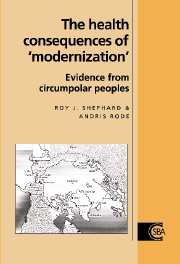Book contents
- Frontmatter
- Contents
- Preface
- 1 The circumpolar habitat and its peoples: traditional lifestyle and early research findings
- 2 Concept of the International Biological Programme Human Adaptability Project, and IBP studies of circumpolar populations
- 3 Changes in social structure and behaviour
- 4 Secular trends in diet, metabolism and body composition
- 5 Secular trends in physical fitness and cold tolerance
- 6 Secular trends in respiratory hazards, lung function and respiratory disease
- 7 Secular trends in growth and development
- 8 Current health status of circumpolar populations
- 9 Postscript: lessons from traditional circumpolar life and options for the future
- References
- Index
6 - Secular trends in respiratory hazards, lung function and respiratory disease
Published online by Cambridge University Press: 05 March 2012
- Frontmatter
- Contents
- Preface
- 1 The circumpolar habitat and its peoples: traditional lifestyle and early research findings
- 2 Concept of the International Biological Programme Human Adaptability Project, and IBP studies of circumpolar populations
- 3 Changes in social structure and behaviour
- 4 Secular trends in diet, metabolism and body composition
- 5 Secular trends in physical fitness and cold tolerance
- 6 Secular trends in respiratory hazards, lung function and respiratory disease
- 7 Secular trends in growth and development
- 8 Current health status of circumpolar populations
- 9 Postscript: lessons from traditional circumpolar life and options for the future
- References
- Index
Summary
Acculturation of the indigenous circumpolar populations to an urban lifestyle has changed many factors which could potentially influence lung function. In addition to possible secular changes in body dimensions (Chapter 7), cigarette smoking has become an almost universal habit among the older children and adults of many indigenous circumpolar groups. Furthermore, the per capita consumption of cigarettes has increased as the cash income of the arctic residents has risen. The overall duration of cold exposure has decreased for most circumpolar people as a consequence of the move from overnight encampments to life in permanent settlements, but the operation of high-speed snowmobiles may have increased the periodic inhalation of very frigid and dry arctic air for at least some of these individuals. Exposure to the smoke from oil lamps has greatly diminished (Beaudry, 1968), but this source of air pollution has been replaced by exposure to quite high concentrations of second-hand cigarette smoke from an early age. Physical fitness has diminished substantially in some circumpolar populations (Chapter 5). Finally, minor respiratory infections remain endemic among young children, although tuberculosis (which was a major consequence of early contacts with ‘white’ immigrants) has now been largely controlled. This chapter discusses the course of these various secular changes in relation to alterations in the lung function of circumpolar populations, which are seen both in children and in adults.
Secular changes of body size
According to proportionality theory, static lung volumes such as vital capacity should be a cubic function of stature (Von Döbeln, 1966). Thus, a small secular change in the average standing height of a population might make a considerably larger difference to its average lung volumes.
- Type
- Chapter
- Information
- The Health Consequences of 'Modernisation'Evidence from Circumpolar Peoples, pp. 151 - 185Publisher: Cambridge University PressPrint publication year: 1996



